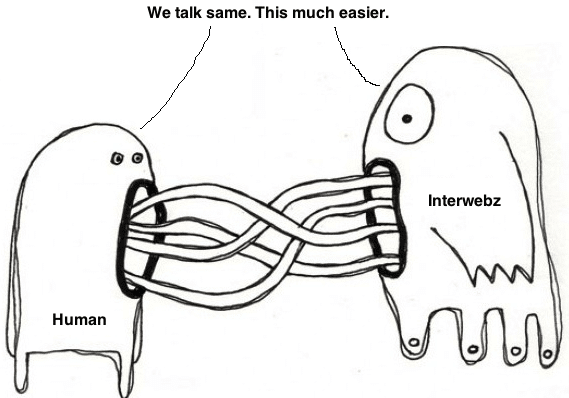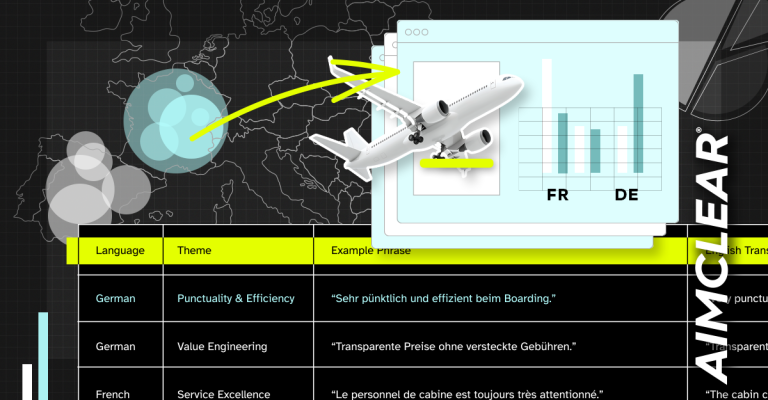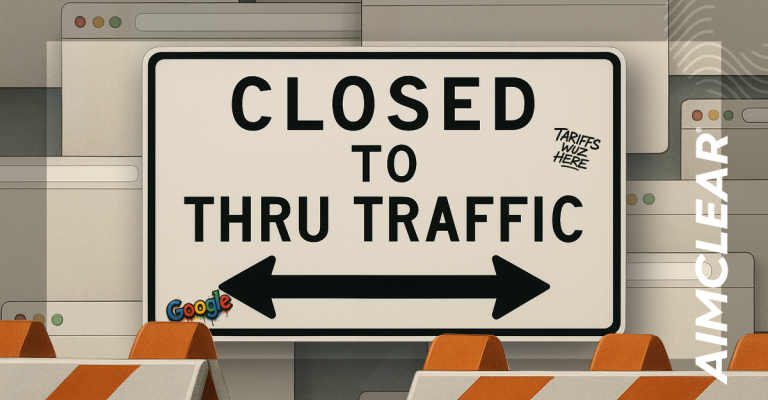
Welcome back to AIMCLEAR‘s coverage of #SMX East 2011! Ah, the fine art of communication. In the good old days, we could all freely converse with one another. Then, some brilliant folks got the idea to erect the Tower of Babel to get closer to the Big Man Upstairs, and we all know what happened there. Now, a zillion years later, we’re at it again – but this time, we’re not bridging the communication gap between [wo]man and neighbor. This time, we’re connecting [wo]man and machine.
And this time, it ain’t no tower unifying our language. It’s Schema.org, Rel=author, and other intuitive meta tags clarifying human-created content for robot-powered search engines so that other human-users can have a better overall experience.
The afternoon of Day 2 at #SMX East brought together moderator Vanessa Fox, Contributing Editor, Search Engine Land, Q&A moderator Lisa Williams, President, MEDIA forte marketing, and speakers Janet Driscoll Miller, President and CEO, Search Mojo, Topher Kohan, SEO Coordinator, CNN, and Product Management Director, Search, Google. Janet and Topher shared tip-top tactics and advice for leveraging the universal language Schema.org and various meta tags of 2010 represent while Jack was there to be grilled by Vanessa and the crowd. AIMCLEAR live-tweeted this session via @beebow. Read on for the full recap.
Vanessa welcomed attendees back from launch and introduced the session.
“A lot of people in SEO think a lot about ranking… that tends to take a lot of the focus… but there’s other parts to be considered,” she began.
What does the SERP actually look like? The SERP houses a ton of opportunity for you as a site owner to engage with people. The actual landing page is incredibly important, too. But for the sake of this session, we’re going to focus more on the SERPs and how you can beef up your presence.
Topher took the stage to deliver his magnificently titled presentation: “Semantic Markup and You!”
The semantic web (or structured code), like that incorporated by Schema.org and microformats, is a ‘man-made woven web of data’ that facilitates machines to understand meaning of information on the Internet. It gives meaning and structure to data on the web, it takes data users can read, and gives it meaning so that people can use it in other methods, rather than just reading.
Microformats were the originator of semantic movement, but technically, microdata is what Schema.org uses primarily.
And Schema.org is…
Schema.org is an open source set of standard microdata markup to use on video & interactive content. It was originally pursued by Google an Yahoo, but factors in Bing, too. Thing of it as a language the three search engines understand and speak in unison.
A Brief History of Google Speak
- Google Speak on Rich Snippets. In may of 2009, Google announced it’s roll out of rich snippets capable of giving “users convenient summary information about their search results at a glance.”
- Google Speak on Video Markup. This markup adds additional information to videos that search engines can understand. In 2009, Topher’s team added RFDa to video on test sites. What happened?
- 35% increase in number of indexed videos in Google video search
- 22% increase in videos showing up for targeting KWs
- Note: Despite the increase in visibility, Topher’s team removed the code. Why? It tacked on serious page load time. Totally unacceptable. They’re looking to add the code once more, in a leaner and meaner style — in a way that won’t affect page load time (and, by extension, rank).
The Skinny on Rel=author
Rel=author highlights the creator of content, allows authors to be indexed. When marking up with Rel=author, Google would like you to point to the author’s Google profile page, but you don’t have to.
Topher recommends leveraging Rel=author if you work for a content-based organization, as it could be a big game-changer for you in terms of visibility in the SERPs. This isn’t about ranking (and perhaps it’s not even really about getting found)… it’s about letting search engines know what the content is about.
Example: hRecipe, a markup that tells search engines a given piece of content is a recipe.
When Topher’s team implemented hRecipe for one of their web assets, they saw:
- 47% increase of recipes showing in Google (within 24 hours of implementation)
- 22% increase of search traffic to recipe pages
Some Problems with Schema.org
- Schema is a “new” markup
- If your standards have to be in place, it might not go so well
- ROI has to be… existant.
Best Time to Implement Schema Markup
- Moving to a new CMS
- Launching new template or site (from scratch)
- Site redesign
- Down dev cycles
Topher wrapped up: “Peace, y’all.”
Janet was up next. She blazed through some facts on the semantic web and advice for taking it on.
What is structured data? It’s a way to annotate text. Formats include RDFa, microdata, microformats, and the like. Types of structured data for SEO include rich snippets, Rel=Author, schema.org.
What are rich snippets? Why use them?
Google says they result in better CTR. Is it true? *Shrug* Janet can’t say for sure rich snippets always translate to a better CTR. They do, however, affect visibility of a listing.
Rich snippets types:
- Reviews*
- People*
- Products
- Businesses & organizations
- Recipes*
- Events
- Music
(*= Used by Bing as well as Google.)
How do you implement rich snippets? It’s all done by super simple coding. The challenge comes with scalability. If you have a HUGE site (like Topher with, um, CNN.com), it is a HUGE undertaking to implement structured data across your pages. But if you have a smaller site, you should totally take advantage of markups. They will impact visibility.
Rel=Author Problems
- Doesn’t support multiple author blogs (or, at least, it’s tricky to get it to work)
- Only works on same site
- Only works on self-hosted sites
Implementing Rel=author: A Step by Step Guide
- Step 1: From author name on blog post, link to author page of blog. On that link, add rel=”author” to that link.
- Step 2: On author page, create link to your Google+ profile. Tag link with rel=”me”.
- Step 3: On Google profile page, create link to author page of your blog. Be sure to check “This page is about me” box.
Schema.org
Created by Google, Bing & Yahoo, Schema.org launched in June ’11. It represented a way for search engines to collectively understand information. Schema.org is very comprehensive– it understands persons, organizations, creative works, events, products and offers, and more.
Janet recommends checking out: google.com/webmasters/tools/richsnippets, a handy tool for testing the way your rich snippet will appear in a SERP. She called it, “The best tool ever, but it doesn’t always work.” So… keep that in mind.
Janet wrapped up and all who was left was Jack from Google. Here’s some paraphrased bite-sized nuggets from the Q&A that ensued:
Vanessa: Why Schema.org?
Jack: Schema.org is a vocabulary we’re trying to get everybody on the same page of using. While it does use microdata, typically at Google we’ve always been agnostic with types of markup. So if you love RDFa, and have done markup on your site with that, that’s fine, you can use that. Keep in mind though that HTML 5 and web as a standard, is moving towards microdata. So we suggest using that. Google will not phase out other parses, though. Rest easy, weary site master.
Vanessa: Do you have any thoughts on if any markup will influence indexing for relevance?
Jack: It’s really, really, really, really hard for a search engine to figure out what the Internet is saying. It’s not as intuitive an experience as it is for users. Anything that can be done to give search engines hints (wink: structured data) helps them deliver better results. Does that directly lead to double-plus goodness? I don’t know… *smile*.
Jack (On the Race to Implement Schema Markups): Schema.org is forward thinking. Not all of the markups actually do stuff now. We’re ahead of ourselves with the definitions. You can implement all the tags you want, but that doesn’t mean they will actually mean anything… yet…
Vanessa: Any more rich snippets we should be mindful of?
Jack: Janet’s list was pretty much it. There’s some more for mobile application stores, but that’s a small portion of sites out there.
Vanessa: In terms of multiple author blogs using Rel=Author, can it work? How hard it is?
Topher: We got it to work, but it was a lot of hoop-jumping, a lot of phone calls to Google, who was really helpful.
Jack: We’re sorry for any hassle you guys have encountered. Remember, it’s still a new markup, there’s still kinks. That said, we will work to make it easier, maybe post an official blog better explaining how to accomplish this.
Vanessa: Do you typically see CTR increasing for sites with markup, even if ranking stays exactly the same?
Jack: Yep. (With slight caveats.) It should be better for you. That’s what our goal is.
Vanessa: Someone in the crowd has noticed listings in the SERPs for their pages with title tags different from the ones they’ve created. What’s up with that, yo?
Jack: Um… yeah, sometimes Google makes tweaks to titles to make the content better resonate with the query, to make the user experience better.
And on that… eerie note… the session moved towards a conclusion…
Big thanks to the panelists for a tip-top discussion and sneak-peek into the future, which is underway today. Stay tuned in AIMCLEAR blog for more lively coverage from #SMX East 2011!








